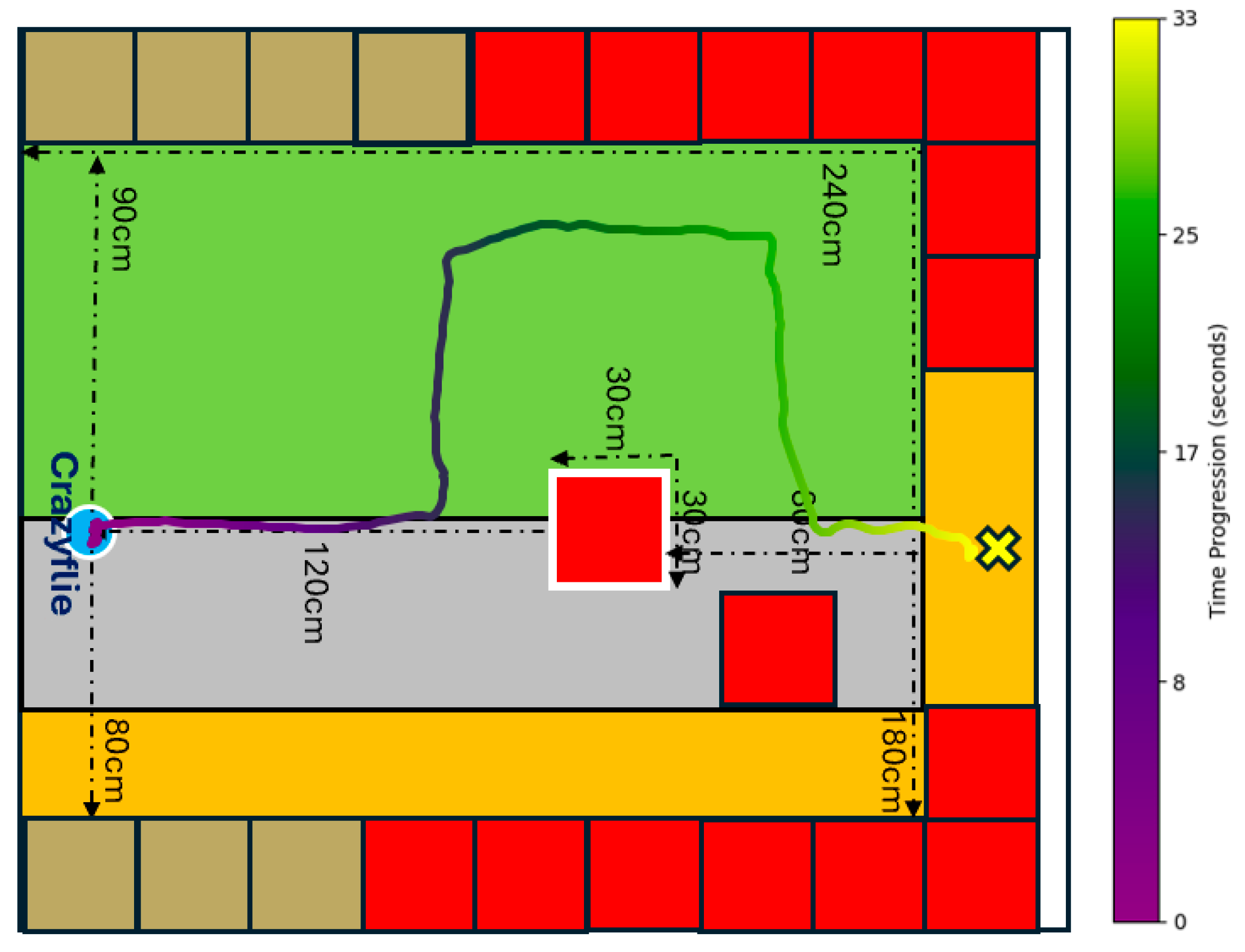Optical-Flow-Based Algorithm of Depth Estimation with Model-Free Control Policy on Autonomous Nano Quadcopters for Obstacle Avoidance †
Abstract
1. Introduction
2. Materials and Methods
2.1. Nano Quadcopter Platform, Test Environment Construction
2.2. Control Policy
3. Results and Discussion
Author Contributions
Funding
Institutional Review Board Statement
Informed Consent Statement
Data Availability Statement
Conflicts of Interest
References
- Floreano, D.; Wood, R.J. Science, technology and the future of small autonomous drones. Nature 2015, 521, 460–466. [Google Scholar] [CrossRef] [PubMed]
- Bodin, B.; Wagstaff, H.; Saecdi, S.; Nardi, L.; Vespa, E.; Mawer, J.; Nisbet, A.; Luján, M.; Furber, S.; Davison, A.J.; et al. SLAMBench2: Multi-Objective Head-to-Head Benchmark- ing for Visual SLAM. In Proceedings of the IEEE International Conference on Robotics and Automation, Brisbane, Australia, 21–25 May 2018; pp. 3637–3644. [Google Scholar]
- McGuire, K.N.; De Wagter, C.; Tuyls, K.; Kappen, H.J.; de Croon, G.C.H.E. Minimal navigation solution for a swarm of tiny flying robots to explore an unknown environment. Sci. Robot. 2019, 4, eaaw9710. [Google Scholar] [CrossRef] [PubMed]
- Duisterhof, B.P.; Li, S.; Burgues, J.; Reddi, V.J.; de Croon, G.C.H.E. Sniffy Bug: A Fully Autonomous Swarm of Gas-Seeking Nano Quadcopters in Cluttered Environments. In Proceedings of the IEEE International Conference on Intelligent Robots and Systems, Prague, Czech Republic, 15–19 July 2021; pp. 9099–9106. [Google Scholar]
- Gao, P.; Zhang, D.; Fang, Q.; Jin, S. Obstacle avoidance for micro quadrotor based on optical flow. In Proceedings of the 29th Chinese Control and Decision Conference, CCDC, Chongqing, China, 28–30 May 2017; pp. 4033–4037. [Google Scholar]
- Sanket, N.J.; Singh, C.D.; Ganguly, K.; Fermuller, C.; Aloimonos, Y. GapFlyt: Active vision based minimalist structure- less gap detection for quadrotor flight. IEEE Robot. Autom. Lett. 2018, 3, 2799–2806. [Google Scholar] [CrossRef]
- Bouwmeester, R.J.; Paredes-Vallés, F.; de Croon, G.C.H.E. NanoFlowNet: Real-time Dense Optical Flow on a Nano Quadcopter. In Proceedings of the 2023 IEEE International Conference on Robotics and Automation (ICRA), London, UK, 29 May–2 June 2023; pp. 1996–2003. [Google Scholar] [CrossRef]
- Yeh, C.F.; Tang, C.Y.; Chen, T.C.; Chang, M.F.; Hsieh, C.C.; Liu, R.S.; Tang, K.T.; Lo, C.C. FlowDep—An efficient and optical-flow-based algorithm of obstacle detection for autonomous mini-vehicles. TechRxiv 2024, 03. [Google Scholar] [CrossRef]
- Yeh, C.-F.; Lai, J.-J.; Li, S.-Q.; Hsiao, F.-K.; Yu, K.-C.; Jhang, J.-M.; Lo, C.-C.; Yang, Y.-T. Implementation of an efficient and optical-flow-based algorithm of depth estimation on autonomous nano quadcopters for obstacle avoidance. In Proceedings of the 2025 11th International Conference on Control, Automation and Robotics ICCAR, Kyoto, Japan, 18–20 April 2025. [Google Scholar]
- Kroeger, T.; Timofte, R.; Dai, D.; Van Gool, L. Fast Optical Flow using Dense Inverse Search. arXiv 2016, arXiv:1603.03590. Available online: http://arxiv.org/abs/1603.03590 (accessed on 3 September 2025). [CrossRef]
- Cho, G.; Kim, J.; Oh, H. Vision-Based Obstacle Avoidance Strategies for MAVs Using Optical Flows in 3-D Textured Environments. Sensors 2019, 19, 2523. [Google Scholar] [CrossRef] [PubMed]
- Müller, H.; Niculescu, V.; Polonelli, T.; Magno, M.; Benini, L. Robust and Efficient Depth-Based Obstacle Avoidance for Autonomous Miniaturized UAVs. IEEE Trans. Robot. 2023, 39, 4935–4951. [Google Scholar] [CrossRef]


Disclaimer/Publisher’s Note: The statements, opinions and data contained in all publications are solely those of the individual author(s) and contributor(s) and not of MDPI and/or the editor(s). MDPI and/or the editor(s) disclaim responsibility for any injury to people or property resulting from any ideas, methods, instructions or products referred to in the content. |
© 2025 by the authors. Licensee MDPI, Basel, Switzerland. This article is an open access article distributed under the terms and conditions of the Creative Commons Attribution (CC BY) license (https://creativecommons.org/licenses/by/4.0/).
Share and Cite
Lai, J.-J.; Li, S.-Q.; Hsiao, F.-K.; Lin, J.-L.; Lai, J.-H.; Yeh, C.-F.; Lo, C.-C.; Yang, Y.-T. Optical-Flow-Based Algorithm of Depth Estimation with Model-Free Control Policy on Autonomous Nano Quadcopters for Obstacle Avoidance. Eng. Proc. 2025, 108, 30. https://doi.org/10.3390/engproc2025108030
Lai J-J, Li S-Q, Hsiao F-K, Lin J-L, Lai J-H, Yeh C-F, Lo C-C, Yang Y-T. Optical-Flow-Based Algorithm of Depth Estimation with Model-Free Control Policy on Autonomous Nano Quadcopters for Obstacle Avoidance. Engineering Proceedings. 2025; 108(1):30. https://doi.org/10.3390/engproc2025108030
Chicago/Turabian StyleLai, Jia-Jun, Sheng-Qian Li, Fang-Kai Hsiao, Jheng-Lin Lin, Jhin-Hao Lai, Chen-Fu Yeh, Chung-Chuan Lo, and Ya-Tang Yang. 2025. "Optical-Flow-Based Algorithm of Depth Estimation with Model-Free Control Policy on Autonomous Nano Quadcopters for Obstacle Avoidance" Engineering Proceedings 108, no. 1: 30. https://doi.org/10.3390/engproc2025108030
APA StyleLai, J.-J., Li, S.-Q., Hsiao, F.-K., Lin, J.-L., Lai, J.-H., Yeh, C.-F., Lo, C.-C., & Yang, Y.-T. (2025). Optical-Flow-Based Algorithm of Depth Estimation with Model-Free Control Policy on Autonomous Nano Quadcopters for Obstacle Avoidance. Engineering Proceedings, 108(1), 30. https://doi.org/10.3390/engproc2025108030






